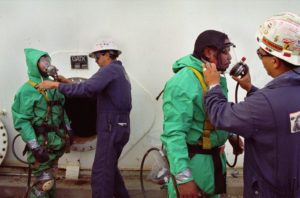The Fight to Toughen California’s Refinery Safety Rules
The turning point in the effort to ensure safe workplaces for refinery workers happened four years ago in Richmond, California. A pipe carrying fuel oil ruptured and released flammable vapors that ignited into a massive fireball. By sheer luck alone, 18 workers lived to tell the tale.

Refinery contractors prepare to enter a drained fuel tank to inspect welds. Photo by Earl Dotter. Used with permission.
The BlueGreen Alliance has joined with members and allies in California to fight for tougher standards to protect workers at the state’s refineries. The standards we’re pushing for can serve as a national model that will help ensure the people working at extremely dangerous jobs—and they don’t get much more dangerous than being a worker or firefighter at a facility that produces flammable liquids—are safeguarded using proven, common sense methods.
The turning point in the effort to ensure safe workplaces for refinery workers happened four years ago in Richmond, California. A pipe carrying fuel oil ruptured and released flammable vapors that ignited into a massive fireball. By sheer luck alone, 18 workers lived to tell the tale. Around the facility, 15,000 residents downwind of the fire had to seek medical attention.
Mike Wilson is the director of the BlueGreen Alliance’s Occupational and Environmental Health Program, and for him this fight to protect workers is personal. As he said in an opinion piece in the San Francisco Chronicle:
“For 33 years, my grandfather, Ed Wilson, worked as an engineer at the Union Oil refinery in what was then the town of Oleum, near the city of Hercules. He was the son of Swedish immigrants and a graduate of Cal Tech, and he worked long hours making sure the plant ran safely, without fail. If he were alive today, I think he would be dismayed to learn what happened at Chevron.”
Wilson went on to describe the years of warnings that were ignored by the company and how this near-catastrophe has driven unions, community groups, and environmental and economic justice advocates to push the state to toughen up its safeguards.
“For 33 years, my grandfather, Ed Wilson, worked as an engineer at the Union Oil refinery in what was then the town of Oleum, near the city of Hercules… If he were alive today, I think he would be dismayed to learn what happened at Chevron.”
“The silver lining of the Chevron refinery story starts in the governor’s office. Just days after the incident, Gov. Jerry Brown assembled an interagency working group to assess the state’s refinery safety regulations. Now — four years later — the state’s redrafted regulation is poised for adoption. As chief scientist in the state’s Department of Industrial Relations, I helped draft the regulation, and I continue to follow the issue in my work with the BlueGreen Alliance, a national coalition of labor unions and environmental organizations.
“If enacted, the regulation will enable plant engineers and other experts —including union safety representatives — to identify hazards and correct them, not with temporary patches or other Band-Aid measures, but with high-quality engineering solutions known collectively as ‘inherently safer technologies.’ Reinforced with deadlines and reporting requirements, along with the enforcement teeth of the state’s Division of Occupational Safety and Health, the regulation should make it nearly impossible for plant managers to drive a refinery to the point of failure.”
He concludes, “The new regulation, in its strongest form, might give the industry’s corporate leaders heartburn, but there is no question that — at some point in California’s future — it will save lives. With a nod to Bhopal, to Richmond and to Torrance, California is on the cusp of reinventing industrial safety by making it much harder for corporations to dismiss the insights of engineers and plant operators. I think my grandfather would read the governor’s proposal and smile.”
If you want to stay up to date on Mike’s and the BlueGreen Alliance’s efforts to ensure refinery jobs are safe and healthy jobs, make sure to sign up for our monthly newsletter The Ally. You can do so here.